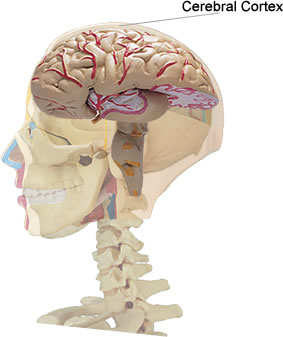Cerebral Cortex: Difference between revisions
No edit summary |
No edit summary |
||
| Line 5: | Line 5: | ||
</div> | </div> | ||
== Introduction == | == Introduction == | ||
The cerebral cortex is the | [[File:Cerebral Cortex location.jpg|right|frameless|337x337px]]The cerebral cortex is a sheet of neural tissue that is outermost to the cerebrum of the mammalian brain. It has up to six layers of nerve cells. It is covered by the meninges and often referred to as gray matter<ref>Kidzsearch [https://wiki.kidzsearch.com/wiki/Cerebral_cortex Cerebral Cortex] Available from:https://wiki.kidzsearch.com/wiki/Cerebral_cortex (accessed 25.12.2020)</ref>. The cortex is gray because nerves in this area lack the insulation (myelin) that makes most other parts of the brain appear to be white<ref>Thought Co. [https://www.thoughtco.com/anatomy-of-the-brain-cerebral-cortex-373217 What Does the Brain's Cerebral Cortex Do?] Available from:https://www.thoughtco.com/anatomy-of-the-brain-cerebral-cortex-373217 (accessed 25.12.2020)</ref>. | ||
[ | The cerebral cortex | ||
* Represents in humans a highly developed structure concerned with the most familiar functions we associate with the human brain. | |||
* Highly convoluted external surface of the brain. Its distinctive shape arose during evolution as the volume of the cortex increased more rapidly than the cranial volume resulting in the convolution of the surface and the folding of the total structure of the cortex. | |||
* The convolutions consist of grooves known as sulci that separate the more elevated regions called gyri. | |||
* The cortex has been divided into four lobes using certain consistently present sulci as landmarks. These lobes are named after the overlying cranial bones: frontal, parietal, temporal and occipital<ref>[http://www.ifc.unam.mx/Brain/cercox.htm Nervous system] Available from:http://www.ifc.unam.mx/Brain/cercox.htm (accessed 25.12.2020)</ref>. | |||
== Sub Heading 2 == | == Sub Heading 2 == | ||
Revision as of 07:22, 25 December 2020
Original Editor - Lucinda hampton
Top Contributors - Lucinda hampton, Rucha Gadgil and Joao Costa
Introduction[edit | edit source]
The cerebral cortex is a sheet of neural tissue that is outermost to the cerebrum of the mammalian brain. It has up to six layers of nerve cells. It is covered by the meninges and often referred to as gray matter[1]. The cortex is gray because nerves in this area lack the insulation (myelin) that makes most other parts of the brain appear to be white[2].
The cerebral cortex
- Represents in humans a highly developed structure concerned with the most familiar functions we associate with the human brain.
- Highly convoluted external surface of the brain. Its distinctive shape arose during evolution as the volume of the cortex increased more rapidly than the cranial volume resulting in the convolution of the surface and the folding of the total structure of the cortex.
- The convolutions consist of grooves known as sulci that separate the more elevated regions called gyri.
- The cortex has been divided into four lobes using certain consistently present sulci as landmarks. These lobes are named after the overlying cranial bones: frontal, parietal, temporal and occipital[3].
Sub Heading 2[edit | edit source]
Sub Heading 3[edit | edit source]
Resources[edit | edit source]
- bulleted list
- x
or
- numbered list
- x
References[edit | edit source]
- ↑ Kidzsearch Cerebral Cortex Available from:https://wiki.kidzsearch.com/wiki/Cerebral_cortex (accessed 25.12.2020)
- ↑ Thought Co. What Does the Brain's Cerebral Cortex Do? Available from:https://www.thoughtco.com/anatomy-of-the-brain-cerebral-cortex-373217 (accessed 25.12.2020)
- ↑ Nervous system Available from:http://www.ifc.unam.mx/Brain/cercox.htm (accessed 25.12.2020)







